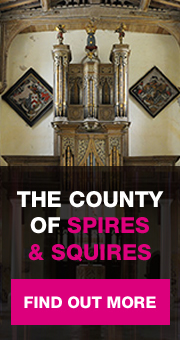A wonderful juxtaposition of medieval England and the advance of 19th century technology. This towered and spired church, built in both limestone and ironstone, lies adjacent to the great arched Welland Viaduct, in polychrome brick, built by John Underwood in the 1870’s for the Midland Railway.
Internally the church is a square with arched divisions creating north and south aisles with a tower base and a chancel. It is as handsome an example of a medieval church as you will find in the north part of the county.
It is the sort of church that gave the county its sobriquet of “spires and quires”. Here the squires were the Tryon family who were buried in the north aisle. It is a very curious affair with elaborate wrought iron railings, circa 1700, projecting stairs descending to a vault and others ascending to a raised platform with their monuments.
Moses Tryon, a London merchant of Dutch origin, bought the estates here and at Bulwick from the Zouche family circa 1620. Moses and the next three generations are well commemorated in John Stanton’s baroque wall monument. Here amongst other such memorials stands the church organ on the platform giving the space a rather jaunty appearance.
In the north trancet you will discover a sixteenth century helmet hanging on the wall which is all that’s left of a fewnery monument to Lord George Zouche (D. 1569). His descendant Edward, 11th lord Zouche (1556-1625) is remembered as being the sole commissioner at the trial of Mary, Queen of scots at Fotheringhay who voted against her sentence of death.
Please refer to the Glossary for any terms in the text that you are unfamiliar with.







